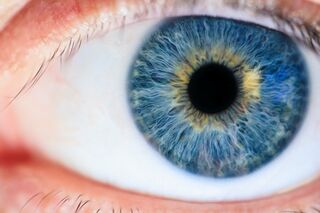Deception
What Everyone Needs to Understand About Human Vision
Learning how we see and avoiding self-deception.
Posted February 28, 2022 Reviewed by Davia Sills
Key points
- Human vision is a surprisingly creative process.
- Beliefs influence our observations of the world around us, often leading us to see what we expect to see.
- Everything we see is either in the past or a projected estimate of the future.

"He felt all at once like an ineffectual moth, fluttering at the windowpane of reality, dimly seeing it from outside." ―Philip K. Dick, Ubik, 1969 novel
It is close to impossible for us to intuitively understand the complex and surprising process of human vision. As a result, most people lack a fundamental grasp of how they see. This is an odd situation, considering how much we rely on vision.
Although the science is not complete, enough is known for us to think more sensibly about what we “see” and prevent us from placing too much trust in our observations. Unfortunately, overconfidence is common. I encounter it frequently during talks and interviews about extraordinary claims and critical thinking issues. Without hesitation, for example, many people award unjustified credibility to eyewitness accounts of alien visitations, Bigfoot, ghosts, etc. (Harrison 2013).
Science has revealed that human vision is much closer to cognitive theater than video surveillance. But how many people know this? Most are unaware that seeing is largely a creative act, a process that presents us with a version of reality rather than an accurate reproduction. Our eyes and brains simply do not capture and display the world as it really is.
The brain instead produces a customized representation of a scene. What we see, as a matter of routine, are functional fantasies meant to be of practical use. If more people filtered every important observation through an awareness of this, it could substantially reduce self-deception and irrationality. And that would be a significant step toward a more sensible world.
A Quick Glance at How We See
Human vision begins when photons (particles of light) hit the eye. The retina performs a bit of nature’s magic by converting this light energy into electrical information, which races along the optic nerve to the brain. Once there, this raw data is read or translated as patterns. This is how we identify a big, round shape from a small, square shape or recognize that an attacking lion is not a beautiful flower.
While strange and imperfect, our vision works well enough for us most of the time. After all, our species can juggle, fly airplanes, and paint landscapes. But cognitive missteps are common because the normal vision process includes seeing things that are not there and missing or wildly misinterpreting things that are.
Too many people wrongly assume that human vision works something like a camera and accurately relays reality into our brains. This is a problem because excessive trust in the eyes can make one less likely to entertain doubts or seek confirming evidence after witnessing something significant. We all are prone to fooling ourselves in many ways, but excessive trust in vision is one of the quickest and surest routes to self-deception.
Vision takes up a large portion of overall brain activity, so it makes sense that the brain would seek efficiency by minimizing data clutter. When we look at a lawn, we do not need to be swamped with the visual detail of every blade of grass. Unfortunately, most people probably don’t realize just how much detail is left out. The brain only shows us an extremely small area in conscious focus. Typically, more than 99 percent of the surrounding environment is effectively absent. We miss a lot (Chabris and Simons 2010). Perhaps most troubling, however, is how our beliefs and past experiences can influence what we see.
"We do not see the world. We watch internal movies about the world."
Most people I engage with on this topic are shocked to learn that fill-in images of things not present can be wholly created based on what the subconscious brain deems useful, desirable, expected, or consistent with a belief. They tend to be even more surprised when I explain that research shows we may naturally place more trust in these made-up visual images than we do images of things present in reality (Ehinger 2017). So, to recap, scenes we see in our heads are not only incomplete and highly edited but also routinely include imaginary elements. It is as if there is a screenplay to consult, and we all have a Hollywood CGI special-effects team in our heads. We do not see the world. We watch internal movies about the world. To be fair, let’s call them docudramas, presentations rooted in fact—but with ample artistic leeway.
Seeing is Believing vs. Believing is Seeing
If one morning, for some unknown reason, a large hole opened up in your living room floor, you might not see it. It’s right there in front of you. Your eyes travel over it. But it goes unseen in your brain. Why? You don’t see it because it shouldn’t be there. It’s an unexpected deviation from the reliable playbook. You believe in a solid living room floor, and that is what your brain sees. So, you step into the hole and fall to your death.
The influence of belief on our visual perceptions likely explains countless eyewitness claims of extraordinary and unlikely phenomena. An unidentified light in the sky, for example, might be seen very differently by people with different beliefs. Based on what we know about the interplay between belief and vision, enthusiastic UFO believers would be more likely to see an obvious alien spaceship in considerable detail than those who do not hold the prior belief. A line from Frank Herbert’s novel Dune comes to mind: “Hope clouds observation.”
Not only do we fail to see the world accurately or in full, neither do we see it in real-time. Everything we observe around us is old news. It already happened (Anwar 2013; Maus 2013). We visually experience our environments with a delay of hundreds of milliseconds. That may not sound like much, but sometimes it matters. The human brain evolved to cope with this delay reasonably well in most scenarios. It naturally makes subconscious attempts to estimate the speed and path of objects in motion and then show us projected or expected images of where they will be. This means the “present” that we see around us is a mixture of the past and an anticipated future.
None of this information is meant to belittle or denigrate our eyes and brains. The system of human vision is amazing and wonderous, a magnificent evolutionary achievement. But it is vital that we understand its unusual ways—and keep a close eye on the peculiar vulnerabilities that come with it.
Facebook image: Olena Yakobchuk/Shutterstock
LinkedIn image: CameraCraft/Shutterstock
References
Harrison, Guy P. 2013. Good Thinking: What You Need to Know to be Smarter, Safer, Wealthier, and Wiser. Amherst, NY: Prometheus Books, 127-138.
Chabris, Christopher and Simons, Daniel. 2010. The Invisible Gorilla: How Our Intuitions Deceive Us. New York, NY: Crown Publishers.
Ehinger, B., et al. 2017. Humans treat unreliable filled-in percepts as more real than veridical ones. eLife, 6:e21761 DOI: 10.7554/eLife.21761.
Maus, Gerrit W., Fischer, Jason, and Whitney, David. Motion Dependent Representation of Space in Area MT+, Neuron 78, no. 3 (May 8, 201): 554–62.




